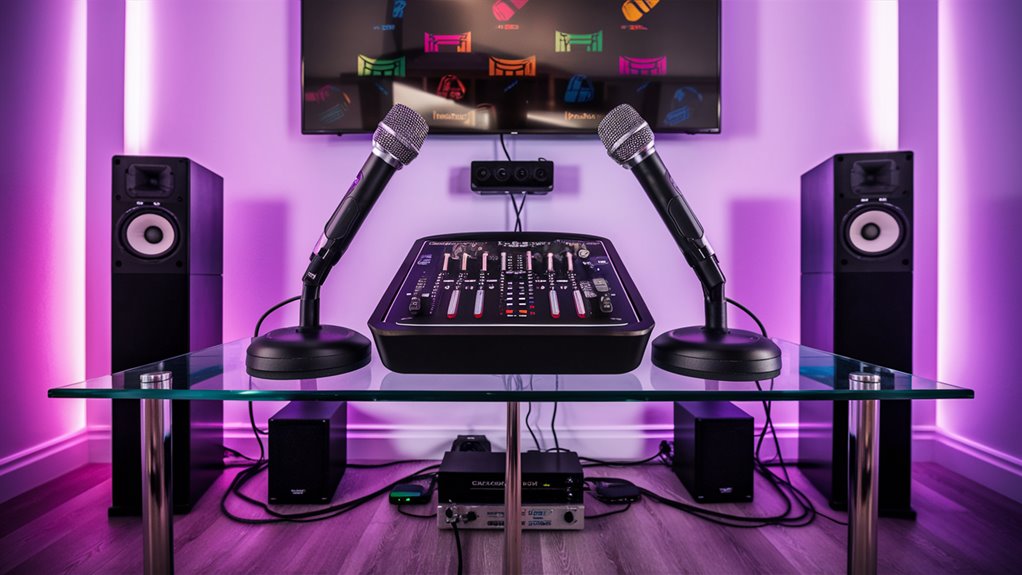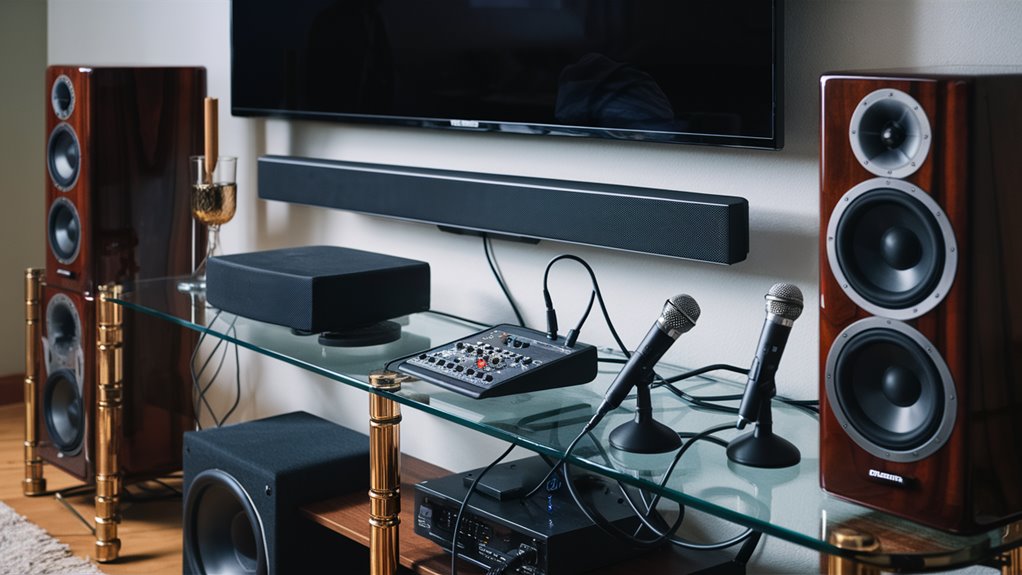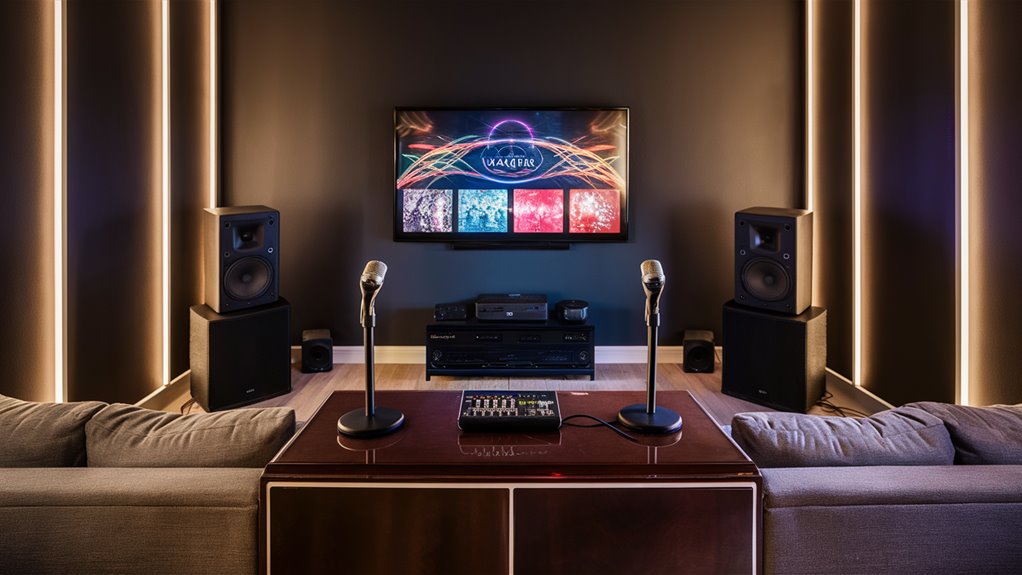How to Set Up a Karaoke System in Your Home Theater

Putting a top-notch home karaoke system in place needs good planning and the right gear. Follow these simple steps for a great singing setup.
Key Gear You Need
Start with a pro karaoke player or a strong PC hooked to a mixing console. Get at least two dynamic XLR mics for clear voice sounds. Your sound gear should have powered speakers or an amp-speaker mix giving out at least 100W RMS for top sound.
Sound Effects and Screen Setup
Put in a digital effects box to add good reverb and echo. Use a 55-inch or bigger 4K TV or a clear projector right at eye level for easy viewing. Place speakers at 30-degree angles from where you’ll sing to set up the best sound space.
Making the Room Sound Better
Put sound panels on walls facing each other to cut echoes and make voices clearer. Set bass traps in corners to manage deep sounds. These changes help with sound quality and keep feedback low in home karaoke setups.
Managing Your Songs
Use pro karaoke software like KaraFun or Virtual DJ to keep your songs in order. These tools have big song lists, playlist tools, and let you change keys in real-time, which are key for a pro setup.
Full Guide to Karaoke Equipment
Main Parts of Your Karaoke Setup
A high-quality home karaoke setup needs several linked parts to give out clear sounds and smooth play. This detailed guide goes over the vital gear for good sound and voice handling.
Source and Sound Gear
- Starts with a karaoke player or sound source that works with various forms, like DVDs, online streaming, and MP3+G.
A top-mic preamp or mixing board is key to handle voice inputs and mix them well with the music.
Mic and Sound
- Top dynamic mics with XLR links are a must for clear sound.
- Using at least two mics lets duets and groups perform while keeping the sound clear and free of issues.
Speaker Needs
To project sound well, set up either:
- Powered speakers (with built-in amps)
- Unpowered speakers with a separate amp (at least 100-watt RMS)
Screens and Effects
- Clear display system – like an LCD TV or projector – helps you see lyrics well.
- Boost singing with a digital effects box offering pro reverb control, echo changes, and live sound handling.
Important Wire Connections
Pro cables make sure signals move well:
- XLR for mics
- HDMI or RCA for sound and video
- Speaker cables for unpowered speakers
- Surge protectors for safety and long use
How to Choose Your Karaoke Sound System: The Ultimate Guide
Key Sound System Parts for Top Karaoke
Picking a sound system is key for any pro-level home karaoke, affecting voice clearness, music play, and overall quality. The best setup relies on three parts: amp power, speaker setup, and subwoofer use.
Amp Needs for Great Karaoke
- Choosing an amp needs thought about power and features. A unit with at least 100 watts per channel gives enough room for energetic shows. How to Get the Best Deal on Karaoke Room Rentals
- Key features include special mic inputs, built-in echo effects , and separate EQ controls.
Having different volume controls for music and voice lets you adjust the mix to get a pro sound balance.
Speaker Setup and Place
Best Speaker Setup
The least suggested is a 2.1 setup, but a 3.1 system with a special center speaker gives better voice projection. Choose speakers with good mid-range response (1kHz-4kHz) for clear voices. Standing speakers cover all frequencies well, while shelf speakers save space without big sound loss.
Subwoofer for Better Bass
A subwoofer is key for strong bass tones under 80Hz, adding depth without blurring voices. An 8-inch or 10-inch powered subwoofer fits most rooms well. Match the subwoofer power to your amp to keep the system balanced and stop loud sound problems.
Guide to Professional Microphone Setup

Picking the Right Mic
Dynamic mics are best for top karaoke singing. The cardioid pickup pattern is best, cutting feedback and lifting voice clearness. Well-known choices like the Shure SM58 and Sennheiser e835 give great performance and last long in the mid-price range.
Pro Links and Sound Handling
- Balanced XLR links cut noise and keep signal good.
- A special karaoke mixer or amp with effects lets you manage EQ for better voice sound, Reverb for a pro feel, Setting up gain right, and Stopping feedback.
Wireless Setup
- UHF wireless systems in the 500-900 MHz range let you move free while keeping good sound.
- Think about: following local frequency rules, stopping mix-ups with other wireless networks, keeping signal steady, and managing battery life.
Speaker Place and System Fine-Tuning
- Putting speakers right is key for top sound: Keep them far from mics
- Turn speakers away from where you perform
- Set gain right
- Watch and fix feedback
The Best Screens for Karaoke
Choosing Display Tech
Your pick of video display affects how your karaoke system works and feels.
- New 4K LED TVs give great text clearness and colors for lyrics and videos, best in sizes from 55″ to 85″ for home fun spaces.
Projectors for Big Impact
- Home projectors are great for big screen feel.
- Key things include: At least 2000 lumens bright, 1080p or more for sharp lyrics, special screen for clear text, control over room light.
Smart Screens
- Smart screens have cool add-ons like built-in streaming
- Karaoke apps ready
- HDMI with HDCP ready
- Works with 60Hz
Setting Up the Screen Right
- Set up for best view: Put screen at eye level
- Think about view angles for groups
- Keep a good view distance
- Manage room light right
Pro setups should look at signal clearness, sound sync, and screen tuning for best performance in big or fancy home spots.
How to Set Up the Karaoke Room: Ultimate Acoustics Guide
Making Your Space Sound Perfect
- Setting up a karaoke spot needs careful thought about sound control and space layout for the best sound and crowd fun.
- Put pro sound speakers at ear level, angled 30 degrees toward the room’s middle
The main singing spot sits just right between them.
Pro Sound Control
- Sound soaking is key for great acoustics. Put sound panels on walls facing each other to stop echoes and unwanted sound.
- Bass traps go in corners where deep sound gathers.
For long rooms, put the singing area against the short wall to cut bass issues.
Planning Zones
- Make three main spots for best crowd handling:
- Singing zone (at least 50 square feet)
- Seats for the crowd (6-8 feet from speakers)
- Area for singers to wait (special space for standing in line)
Put sound-killing floors like thick carpet or rubber mats in the singing area to stop foot noise.
In places with hard floors, use sound control stuff like soft chairs and thick curtains to spread sound right and stop monitoring problems.
Must-Have Software and Songs for Karaoke Systems
Pro Karaoke Software Options
- Pro karaoke software is central for your fun setup.
- Top tools like KaraFun, Virtual DJ, and Karaoke 5 support many formats and have advanced mixing tools.
- These apps are easy to use, have pro sound handling, and work well with new tech.
Building Your Song List
Paid Streaming vs. Owning Songs
- Digital paid services give quick access to big song lists. 이 가이드에서 자세한 정보 확인하기
- Karaoke Version is known for its huge range and new songs often.
- If you like owning songs, building a personal song list through places like Karaoke Downloads or Party Tyme Karaoke means you always have access to top-quality MP3+G and CDG files.
Linking Everything
Key Connection Parts
Linking a pro karaoke system needs good plan and clean wire work.
Sound Links
- The base is mic links. Link mics to the mixer or karaoke amp using XLR cables or 1/4-inch audio cables.
- Digital mixers need optical or HDMI to the main sound gear.
- While old setups use RCA cables or balanced TRS links for strong signal.
Video Links
- HDMI links are key for video from karaoke sources to screens.
- For software-based karaoke, set audio to mixers while keeping video to screens or projectors separate.
Wireless Setups
- Wireless mic setup needs clear spots for receivers.
- Link receivers to mixer channels for best signal and low interference.
Speaker Links
- Linking speaker systems needs right amp connection using proper speaker wire size.
- Match polarity between amp output and speaker input for best sound spread.
Checking Your System
- Check all links before use, making sure cables are tight and signals go where they should.
- Watch input levels and set gains for best performance across all parts.
